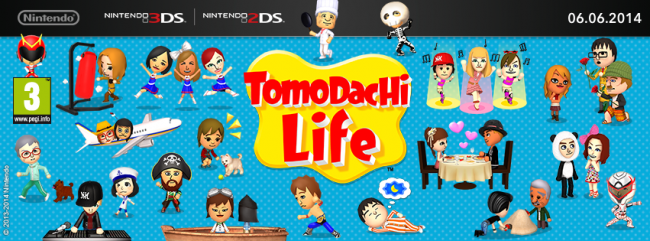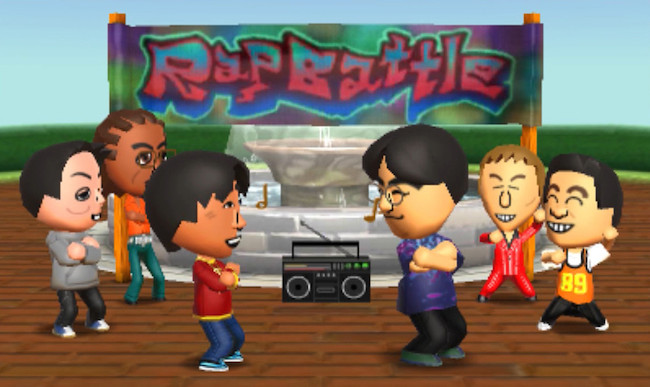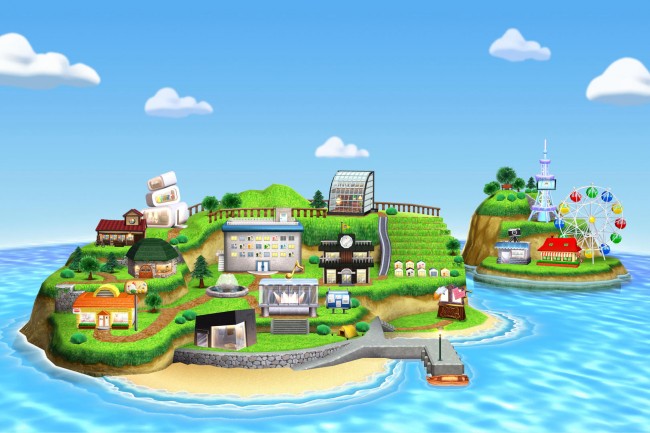
The pull of a sim game partly comes from a sense of voyeurism and curiosity about someone else’s existence, but the omnipotent control freak that emerges when playing games of this genre is incredibly fun, also. Tomodachi Life by Nintendo reached out to sim-players like me, but surprisingly, it also caught the attention of my 8 year old mini-nerd (son). I knew the graphics were a major draw card for a younger gamer, but for this review, I let him take the lead for some aspects, as well as co-playing others; just to see if the odd-ball that is Tomodachi Life worked for either of us.
Grading the narrative for a game within a genre that doesn’t require a conventional story line was easier than I thought. Personally, I see the story as the driving force, the reason you play and finish any given game, and, therefore, an integral piece. Tomodachi, which translates to ‘friend life,’ ensures the player’s interest in the tale is instant and often reinforced by making the pivotal character a Mii of, well, you. It was odd at first, to have these characters you design, physically and otherwise, directing questions and chatter at you and fully accepting that you’re a lookalike puppet master from a different world. At times, it felt like babysitting a mental institute of weirdos you created, yet frequently, I found myself or my son almost bonding with the Miis as we tried to create happiness for them.

The only real story is told through clever, short news broadcasts; basically, alerting you to more of the island opening up, as well as when new are features available. These were helpful, however, as this is a game about relationships, I mostly ignored them to better focus on trying to understand why the Mii of my boyfriend was in a dinosaur costume and chasing paella on a string. I wanted more control over the storyline: to be able to send Miis on dates, or yoga lessons, or to argue with Princess Peach next door who kept making me cry. I found it frustrating only being able to steer, but then I watched my son play. He made Miis with characteristics that would suit others, he made sure to try everything on the island, but more importantly, he spent a lot of time with every individual. While it wasn’t control, he had found a way to really make things on our island come to life, and it grew incredibly entertaining.
Tomodachi Life incorporated bright, chunky visuals well suited to a fun, bubbly game that children can also enjoy. The peaceful little island that slowly became a hub for our brightly coloured folk may have been small, but I found it enjoyable to have my own pretty little island. The details became more and more important as you shaped the island and its people; whether it was the room interiors or the questionable wardrobe choices. The presentation made it easy to tell 20+ Miis apart, and gave life to each of them and their interactions. We didn’t actually mind the elevator music, mostly because it was continuously punctuated by the Miis voicing exactly what was on their mind and within reason; whatever you told them to say. The speech and individualised word-vomits kept us coming back to interact with them.

Nintendo usually delivers with favourable game mechanics, and for me personally, I felt they successfully incorporated the existing Miis into a satisfying game experience. What my son and I both agreed on was that exchanging pop ups and annoying instructions for mini news segments taken over by our Miis was definitely a better way to aid gamers. The stylus or button controls were not only basic and streamlined, but as we discovered, they also offered the player some freedom. For example, we meant to use the stylus to hand a Mii some food, but I accidently slipped and threw the food at the Mii and the plate landed on the floor. The resulting look of shock and the sullen plate retrieval by the Mii had us in fits of laughter and consequently looking for other ways to play.
Tomodachi was designed to reward the player for playing: the more Miis you had, the more there was to do, and the more you did with them, the more that happened. While same-sex couples weren’t allowed, I was impressed by diversity of personalities and relationships. The variation in mini games added some action to the game, and improved interaction with the active Mii while keeping a high level of interest over a longer play time. The most amusing part of the design were the random objects: at first I thought they were just things to collect for my inventory – until I gave someone a sewing machine. What happens next sums up the game fairly accurately: my most macho Mii donned a headscarf and merrily chatted away as he used the sewing machine to create something ‘even baby ducks will be jealous of’. Naturally, we then gave every kind of item to Miis and were rewarded with absolute insanity and hilarity.
 Fun for both children and adults
Fun for both children and adults
 You can always expect the unexpected
You can always expect the unexpected
 There is never a dull moment
There is never a dull moment
 Super easy to pick up and master
Super easy to pick up and master
 Same-gender relationships are not allowed
Same-gender relationships are not allowed
 Only sustains itself in short bursts
Only sustains itself in short bursts
 Would have liked a little more control
Would have liked a little more control
I thought this might not be for me, but then I took a much closer look (incidentally, my Mii had a crab on her shoulder and asked me to remove it…) and I can’t deny the entertainment it provided me. I wouldn’t play this long term, but can definitely see myself and my son going back to the unhinged island to interact with the Miis often. There might not be much at all to control, and nothing for you to do except aid the Miis, but the sheer surprise factor made each visit motivating. The imagination and ludicrous outcomes of Tomodachi Life gave both my son and I hours of delight; it was a fun game to share. If you love to laugh, be creative, and sit back to see what happens – you’ll love this. Just try not to be surprised at the intelligently insightful and introspective bobble heads, even if they are dressed as dinosaurs.











